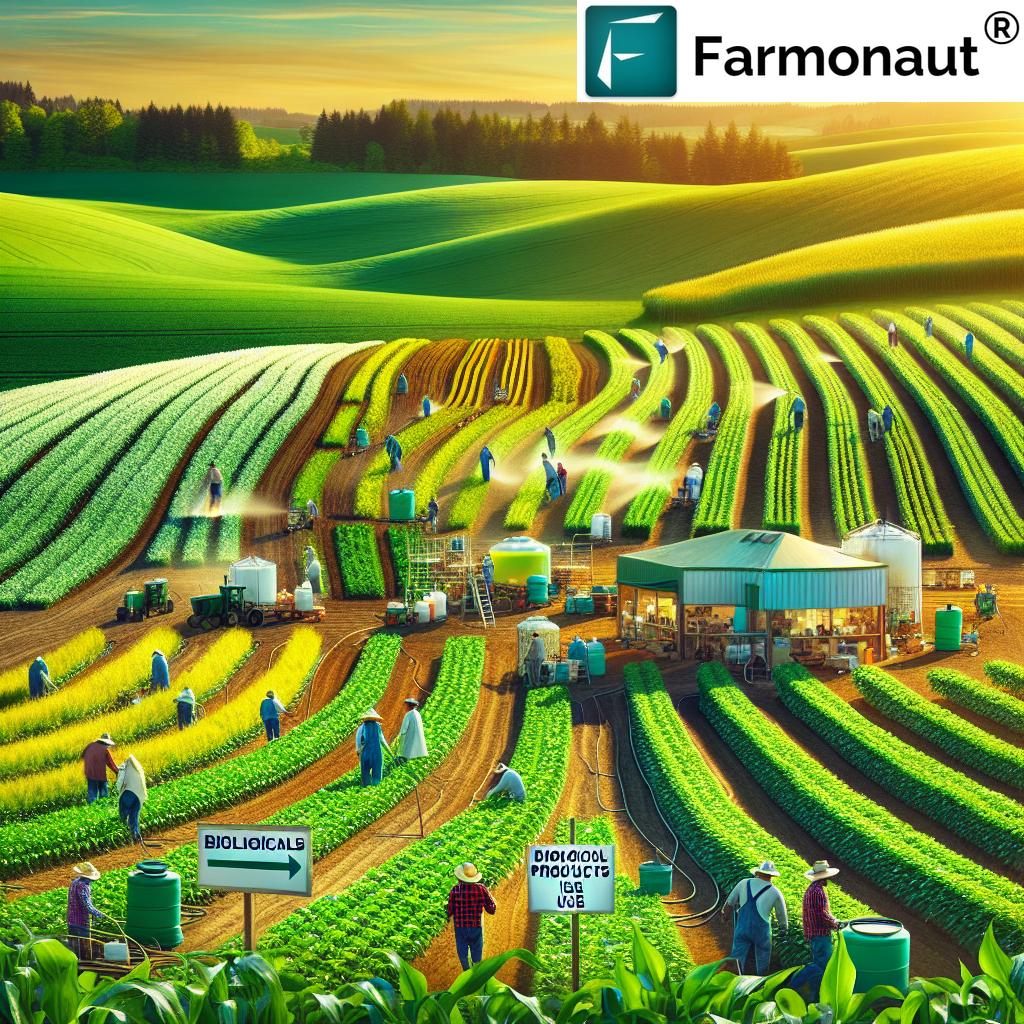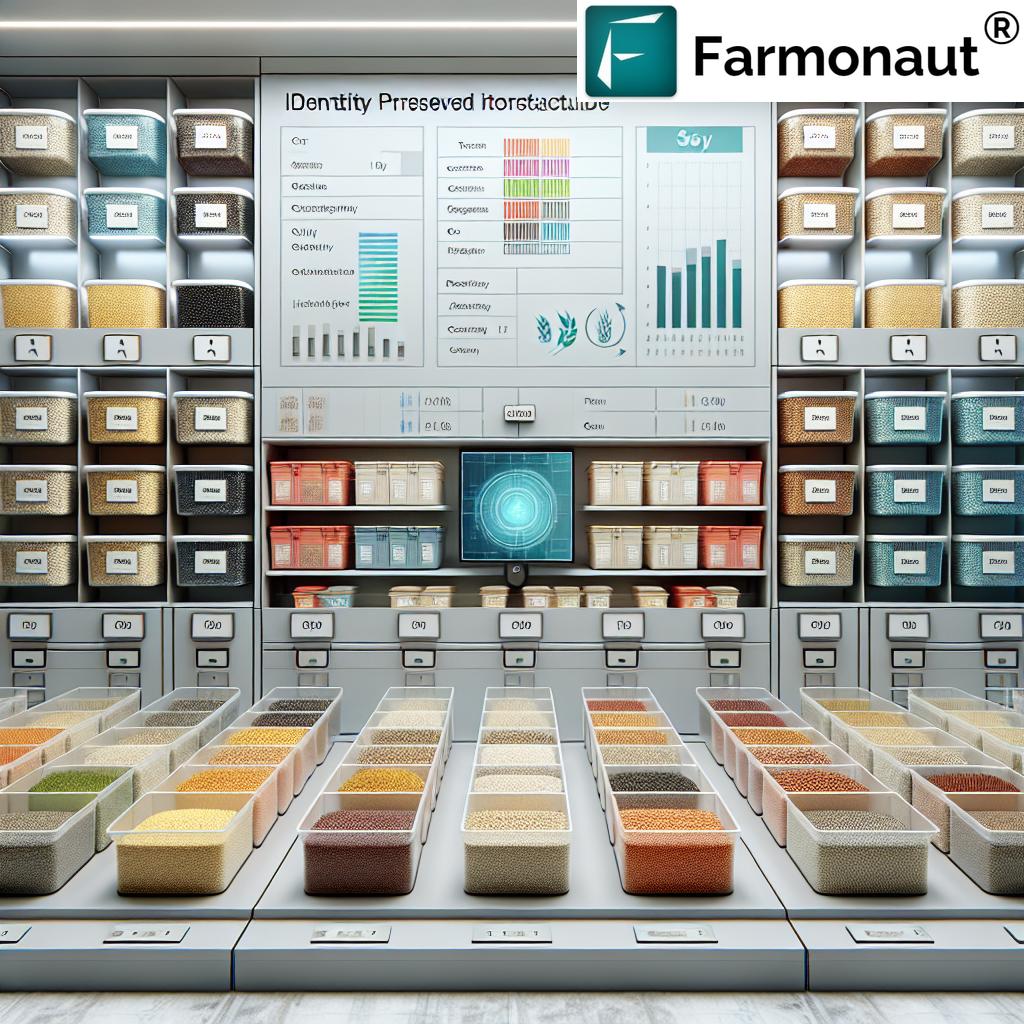Table of Contents
- 1. Introduction: Advancing Agriculture through Climate-Smart Agroecology Programs in 2025
- 2. Understanding Climate-Smart Agroecology in 2025
- 3. Core Principles & Approaches: Agriculture Programs, Agroecology Programs, and Climate Smart Agriculture Program
- 4. Programmatic Landscape in 2025: Strategies, Frameworks, and Innovations
- 5. The Role of Farmonaut: Satellite-Driven Support for Climate-Smart Agroecology
- 6. Environmental and Socioeconomic Impact: New Realities for Farmers & Communities
- 7. Comparative Program Impact Table
- 8. Challenges and the Way Forward for Agriculture Programs in 2025
- 9. Farmonaut Solutions: Apps, API, and Product Innovations
- 10. Frequently Asked Questions (FAQ)
- 11. Conclusion: The Future of Sustainable Agriculture
“By 2025, over 60% of new agriculture programs prioritize climate-smart and agroecological practices for sustainability.”
Agriculture, Agroecology & Climate Smart Programs 2025
As global challenges such as climate change, soil degradation, and resource scarcity intensify, the world is witnessing a paradigm shift in how agriculture programs, agroecology programs, and climate smart agriculture program are designed and implemented. In 2025, these frameworks stand at the forefront of transforming farming into a more resilient, sustainable, and environmentally sound enterprise, equipping farmers with the tools, knowledge, and support to improve food security, adapt to climate variability, restore soil health, and enhance community well-being.
This blog explores how these programs are driving forward sustainable change, the role of innovative technologies such as those provided by Farmonaut, and the holistic impact these efforts are having in rural communities across the world.
“Agroecology initiatives in 2025 aim to improve soil health, impacting yields for more than 500 million farmers globally.”
Understanding Climate-Smart Agroecology in 2025
The rise of agroecology and climate smart agriculture program has been shaped by our growing understanding of ecological processes and the urgency of addressing environmental degradation.
Agroecology programs emphasize ecological principles: promoting biodiversity, enhancing soil health, and optimizing natural resource use.
Meanwhile, climate smart agriculture programs (CSA) focus on three key objectives:
- Increasing agricultural productivity sustainably
- Adapting and building resilience for farmers
- Reducing or removing greenhouse gas emissions when possible
Merging these approaches, modern programs offer holistic solutions for the critical decade ahead.
Core Principles & Approaches: Agriculture Programs, Agroecology Programs, and Climate Smart Agriculture Program
The 2025 landscape demands that agriculture programs, agroecology programs, and climate smart agriculture program shift from generic solutions to more sophisticated, locally tailored and participatory interventions. Here are the defining features:
-
Diversified Cropping Systems:
Utilizing multiple crop species, intercropping, and rotations to break pest cycles, enhance biodiversity, and mitigate weather risks. -
Agroforestry:
Integrating trees and shrubs with crops and livestock to enrich ecosystems, build resilience, and improve carbon sequestration. -
Integrated Pest Management (IPM):
Employing biological controls and reduced chemical inputs for sustainable pest management. -
Organic Amendments:
Applying compost, manure, and biochar to improve soil health and reduce dependency on synthetic fertilizers. -
Conservation Tillage:
Minimizing ≤soil disturbance to protect soil structure, water retention, and biodiversity. -
Water Management Strategies:
Using rainwater harvesting, drip irrigation, and precise scheduling to optimize water resources.
These approaches combine to create resilient agricultural systems, building the capacity to adapt to climate stresses like droughts, floods, and pest outbreaks.
Programmatic Landscape in 2025: Strategies, Frameworks, and Innovations
Modern agriculture programs, agroecology programs, and climate smart agriculture program rely on a multifaceted strategy combining participatory frameworks, digital technologies, capacity-building, and policy support to foster widespread, durable change.
Participatory Frameworks & Community Co-creation
- Involving Local Farmers: Active involvement of farmers as co-designers ensures tailored solutions that fit local agroecosystems and real-world challenges.
- Empowering Underrepresented Groups: Ensuring inclusivity of youth, women, and marginalized communities in program planning and implementation.
Digital Tools, Data-Driven Advisory, and Knowledge Dissemination
Digital platforms have revolutionized the advisory and support landscape for smallholder farmers and rural communities. Weather forecasts, real-time crop status, and actionable recommendations are increasingly accessible through apps, dashboards, and SMS, empowering rapid, informed decisions.
Farmonaut is a market leader in providing such solutions—see our detailed section below.
Other Programmatic Cornerstones in 2025
- Investment in Training: Farmer field schools, workshops, and demonstration plots remain critical for capacity building.
Experience-based learning fosters the confidence and knowledge required for adoption of new agroecology practices and climate resilience strategies. - Institutional & Policy Support: Governments, NGOs, and local authorities play pivotal roles by offering subsidies, supporting sustainable input supply chains, and building strong market linkages.
- Social Safety Nets: Improved crop insurance, risk funds, and weather-indexed products offer farmers more stable income even during climate events.
- Access to Credit: Digital verification and satellite-based assessments (e.g., those offered by Farmonaut’s Crop Loan & Insurance solutions) enable easier access to financing for sustainable agricultural transformation.
Policy and Incentive Innovations
-
Crop Insurance & Resilience Funds:
These are now designed to shield farmers from climate shocks, underpinned by data from real-time satellite assessments and digital monitoring tools ( read more). -
Linking to Sustainable Markets:
Frameworks such as blockchain-based traceability solutions are reducing fraud and helping farmers tap into premium value-chains. -
Subsidized Access to Digital Technologies and Apps:
Programs offer access to decision-support platforms—for monitoring crop health, scheduling irrigation, and tracking carbon emissions.
The Role of Farmonaut: Satellite-Driven Support for Climate-Smart Agroecology
As 2025 brings agriculture further into the data-driven age, Farmonaut offers mission-critical services and innovations to support agroecology programs, climate smart agriculture program approaches, and farmers in over 80 countries.
-
Satellite-Based Monitoring:
Our platform provides detailed multispectral imagery, tracking vegetation health, soil conditions, crop vigor (NDVI), and changes in land use.
• Benefit: Enables timely, tailored management interventions to prevent loss, boost productivity, and reduce environmental impact. -
Jeevn AI-Based Advisory System:
We deliver customized, real-time insights (including weather forecasts and recommendations) to thousands of users, supporting resilient decisions in field management and crop care. -
Carbon Footprinting & Environmental Tracking:
Our tools for carbon monitoring enable farmers, businesses, and governments to quantify and reduce carbon emissions, aligning agricultural operations with global sustainability targets. - Blockchain Traceability: Our blockchain product traceability guarantees transparency at every stage, catering to the new generation of consumers and regulatory demand for verification in food supply chains.
- Fleet and Resource Management: With fleet tracking solutions, we help optimize machinery use and logistics for farmers and agribusinesses, reducing operational costs while supporting sustainable resource use.
We make these tools available through mobile apps, web interfaces (see links below to download or access), and API integrations for seamless developer adoption.
For developers and enterprises: Explore our API platform for integration—and check the API developer documentation to build custom climate-smart tools on top of our satellite data stack.
Comparative Program Impact Table
| Program Type | Key Practices Adopted | Estimated Reduction in Carbon Emissions (tons/year) | Estimated Increase in Yield (%) | Water Use Efficiency (% change) | Farmer Income Growth (%) |
|---|---|---|---|---|---|
| Traditional Agriculture Programs | Monocropping, Conventional tillage, Synthetic chemical inputs | 0–5 | 0–10 | -3 to 5 | 0–7 |
| Agroecology Programs | Diversified cropping, Intercropping, Organic amendments, Agroforestry, IPM | 15–40 | 12–25 | 10–25 | 10–19 |
| Climate Smart Agriculture Programs | CSA + Data-driven management, Advanced water conservation, Digital advisory | 25–60 | 15–30 | 20–45 | 15–28 |
Table: Estimated program impact values are illustrative and reflect average findings from 2023–2025 pilot projects and academic reviews. Actual results in 2025 may vary based on agroecological context, scale, and level of technology adoption.
Environmental and Socioeconomic Impact: New Realities for Farmers & Communities
By 2025, clear patterns have emerged from climate-smart agroecology programs and agroecology programs around the world:
- Soil Organic Carbon: Programs employing organic amendments, no-tillage, and diversified cropping report marked increases in soil organic carbon, leading to better water retention, reduced erosion, and greater fertility.
- Biodiversity Conservation: Agroforestry and integrated cropping restore habitats for pollinators and pest predators, improving natural pest management and crop resilience.
- Nutritional and Economic Diversification: Households adopting diversified cropping systems experience improved food security, greater dietary diversity, and more income streams—from fruits, vegetables, tree crops, and livestock.
- Reduced Resource Dependency: Efficient water management and the use of biological pest controls decrease dependency on synthetic, environmentally hazardous inputs.
- Social Inclusion and Equitable Growth: Programs that dedicate efforts to empower women and marginalized groups help foster social equity, shared prosperity, and stronger community resilience.
Challenges and the Way Forward for Agriculture Programs in 2025
While the promise of agriculture programs, agroecology programs, and climate smart agriculture program is undeniable, a host of challenges remain that must be addressed for transformation at scale:
- Heterogeneity of Agroecosystems: Diverse local conditions require tailored approaches—one-size-fits-all models don’t deliver lasting benefits.
- Resource Constraints and Short-Term Economic Pressures: High upfront costs, labor requirements, and risk perceptions can hold back farmer adoption, especially when support or incentives are lacking.
- Access to Knowledge and Digital Divide: In many rural contexts, limited connectivity or digital literacy can inhibit effective use of advisory platforms and data-driven agriculture management.
- Policy Gaps: Fluctuating regulations, conflicting incentives, or lack of enforcement can undermine the scaling of sustainable agriculture programs.
The way forward requires: cross-sectoral collaboration, continued innovations in digital solutions and climate finance, deepening of policy support, and greater investment in knowledge dissemination (including demonstration plots and workshops led by trusted local facilitators).
Commitment at every level—from farmers and communities to policy-makers and technology providers—is critical for enabling a climate-resilient, sustainable agricultural future in 2025 and beyond.
Farmonaut Solutions: Apps, API, and Product Innovations
-
Farmonaut Web App: Monitor, plan, and manage your fields, crops, or large land parcels using satellite-driven insights—available on web and mobile for maximum flexibility.
Try the Farmonaut Web App -
Farmonaut Android App: On-the-go access to real-time satellite monitoring and advisory for farmers and agribusinesses.
Download for Android -
Farmonaut iOS App: Stay connected to your land’s status with tailored, actionable guidance for precision farming and sustainability.
Download for iOS -
Blockchain Product Traceability: Verify, track, and authenticate supply chain products—protecting your brand and meeting consumer demand for transparency.
Learn about Blockchain Traceability -
Carbon Footprinting: Instantly track and reduce the carbon emissions of your farming operations.
See our Carbon Footprint Tracker -
Fleet Management: Efficiently manage agricultural vehicles, reduce fuel consumption, and cut costs.
View Fleet Management Solutions -
Large-Scale Farming Operations: Specialized tools and dashboards for agro-businesses and government agencies.
Agro-Admin App Details
Ready to scale your climate-smart journey? Use our API or visit the API developer documentation for custom integration into your digital ecosystem.
Farmonaut Subscription Plans
Frequently Asked Questions (FAQ)
- What are the main differences between agriculture programs, agroecology programs, and climate smart agriculture program?
- Traditional agriculture programs often focus on maximizing yields using synthetic inputs and monocropping. Agroecology programs apply ecological principles, optimize natural processes, and foster biodiversity and soil health. Climate smart agriculture programs integrate agroecological methods with digital technologies, data-driven advisory, and climate risk management strategies—maximizing both productivity and resilience.
- How do programs in 2025 use digital tools to support farmers?
- Smartphone apps, dashboards, and advisory platforms provide real-time information about weather, soil status, pests, and disease risks. These technologies, used by providers like Farmonaut, give farmers tailored recommendations—making modern farming more precise and resilient.
- What is the role of Farmonaut in sustainable agricultural programs?
- We provide satellite-based solutions, real-time monitoring, digital advisory, carbon tracking, blockchain traceability, and resource management tools—all designed to empower farmers, businesses, and governments in implementing and scaling climate-smart and agroecology-based farming.
- How are agroecology initiatives helping soil health and carbon sequestration?
- By promoting crop diversity, organic amendments, reduced tillage, and agroforestry, agroecology programs restore soil organic matter and boost microbial life. This enhances carbon storage, reduces emissions, and builds long-term fertility and resilience.
- Can climate smart agriculture program approaches protect farmer income during climate shocks?
- Absolutely. By improving soil and water management, using weather-indexed insurance, and supporting diversified income streams, these programs shield farmers from crop losses due to droughts, floods, or pest outbreaks.
- How can businesses or governments access Farmonaut technology?
- We offer web, Android, and iOS apps; a comprehensive API (see here); and modular integration tools for digital infrastructure, enabling usage from smallholders to national agencies.
Conclusion: The Future of Sustainable Agriculture
The convergence of agroecology principles and climate smart agriculture program strategies marks a pivotal turning point. As we look to 2025 and beyond, agriculture programs that embrace biodiversity, digital innovation, and collaboration across sectors will enable us to face climate challenges with resilience, productivity, and hope.
Technology platforms like Farmonaut ensure that advanced insights, resource management, and traceability are accessible to all, regardless of scale or geography. With committed investment, knowledge sharing, and inclusive policy, both farmers and the planet can thrive.
Join us as we continue advancing agriculture for a sustainable and resilient tomorrow.












